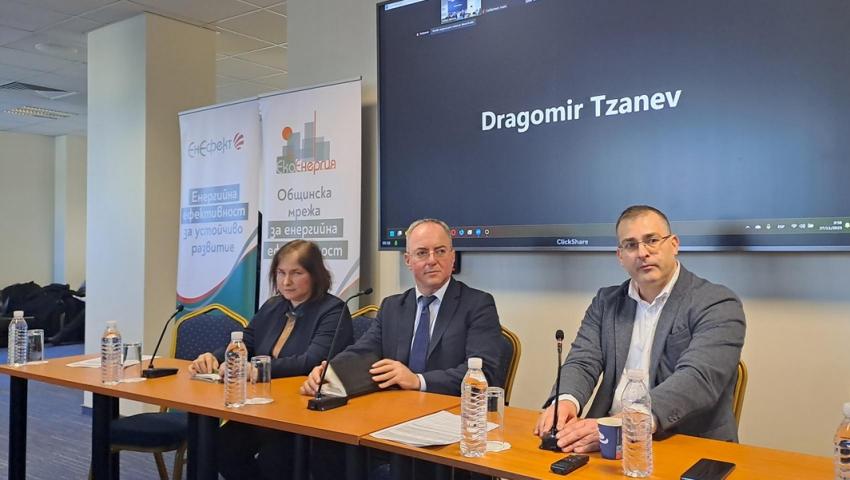The new version of the Integrated Energy and Climate Plan will be ready in March at the earliest
New modeling for decarbonization, reduction of emissions by sector is to be done, commented Deputy Minister of Energy Krasimir Nenov

Raya Lecheva
The new version of the Integrated Energy and Climate Plan will be ready in March at the earliest. This was announced by the Deputy Minister of Energy Krasimir Nenov today at the "Policies and Investments for a Sustainable, Efficient and Secure Energy System" conference. The event is a continuation of the series of round tables for financing sustainable energy and will mark the beginning of the XVII National Conference of the Association of Bulgarian Energy Agencies, organized by EnEffect and the municipal network EcoEnergy.
Quite frankly, I want to share that there is a huge delay in its preparation, Nenov admitted. In March of this year, a report on the implementation of the energy and climate plan was ready, he recalled. The plan itself had to be presented in an initial version to the European Commission at the end of June this year. The final version of the Plan should be ready and sent to Brussels at the end of June next year, but we are getting closer to not having an initial version, but directly sending a final Plan.
The current picture is that an interdepartmental working group of 7 ministries plus the Agency for Sustainable Energy Development has already been established. An updated model for decarbonization and emission reduction and the implementation of specific measures in all sectors of the economy are yet to be developed.
The next steps are in January to receive initial results of the new modeling and after selecting suitable scenarios in March to have final results and a final Plan, said Krasimir Nenov.
In the meantime, we have received proposals for appropriate revisions to the Plan, but the idea is rather to start clean, to have a meaningful Plan that uses all the available expertise that currently exists, to have a document that reflects current realities, added Not new.
The model presented by the Center for the Study of Democracy, which was also discussed in the Energy Transition Commission of the Advisory Council on the European Green Deal, will also be used, and there will be an opportunity to compare the models.
The results of developments to date will be taken into account, within the framework of the Energy Transition Commission, basic work was done in the electricity sector, in terms of consumption it was very thorough with a credible position and it is reasonable to use available results, said the deputy minister on the occasion asked 3eNews which necessitates the use of new modeling.
The modeling done so far concerns consumption and energy capacities, and it is necessary to model all energy and all sectors such as buildings, transport, agriculture. This model is much more comprehensive and will help the Ministry of Environment and Water to calculate emissions more realistically, the experts commented, Alexander Davydov, head of the Department of "Energy Balances, Sectoral Policies, Strategies and Markets" in the Ministry of energy. Until now, the model mainly works with modeling of energy consumption and development of the electricity sector, but not by sector, which is what the modeling is going to do at the moment, Alexander Davydov added. processes in the ministry and provide a ready-made working model that does not depend on external consultants, but is owned by the institutions and used by the Ministry of Energy and the Ministry of Environment and Water, the expert said.
Krasimir Nenov explained that the results of the initial modeling have already been reflected in the approved road map for climate neutrality until 2050.
The expected results are to achieve intermediate terms in terms of coal capacities, the substantive part of the development has not changed, but new data will be set, not from 2018, but from 2021 and the new goals. New RES capacities, development of the network, new nuclear capacities towards the middle of the next decade, gradual reduction of use of coal capacities and attenuation of their functions will be staked. At the moment, the specifics and intermediate dates are missing, what happens between 2020-2025 and 2030-2035.
We will work with new goals for final energy consumption in the country and share of RES. The new documents such as the Integrated Energy and Climate Plan, the Road Map for Energy Neutrality, the territorial plans that caused the miners' protests are documents tied to the preparation of the new energy strategy. It is expected to work on the ecological assessment of the documents, because the latest version of the Integrated Plan has a negative impact assessment.
According to Deputy Minister Angelina Boneva, it is important to know that there will be a redistribution of energy capacities, but not the replacement of each other, from primary power, coal plants will become base power. Our energy industry is undergoing a transformation process that we must manage, all types of energy must go in a different direction, she added.
From basic energy, coal is turning into a balancing, strategic reserve, coal cannot be the basis of electricity production, the sooner we say it, the better, stressed Deputy Minister Boneva.
The best energy that we don't have to use is saved energy. And a 100% grant will never lead to the scale and benefit of energy savings, Boneva said. As long as pricing in the energy sector does not take place on a market basis, there is no way to achieve energy efficiency on a market basis. Therefore, the liberalization of the market will speed up the process of introduction of renewable energy sources, but also of investments in energy efficiency, says Boneva categorically.
